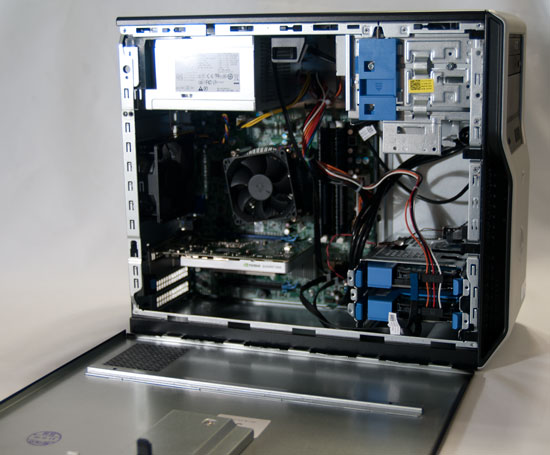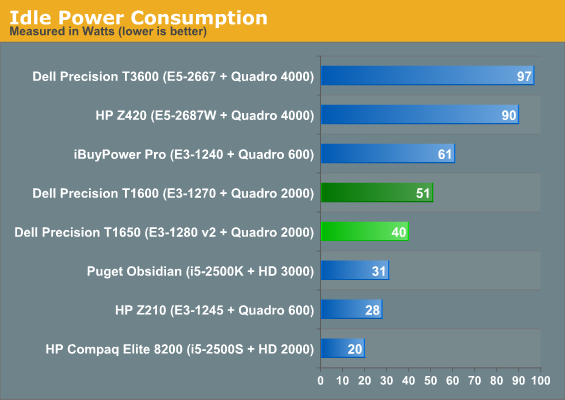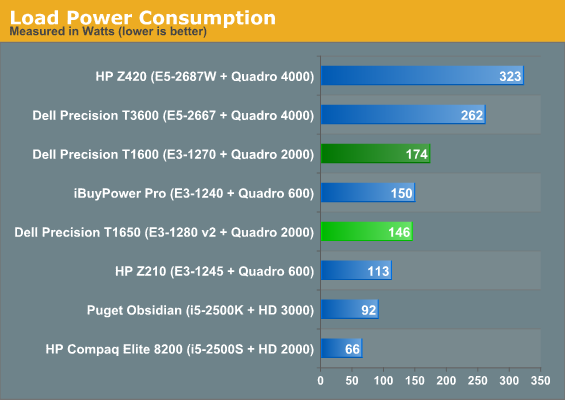Dell Precision T1650 Workstation Review: Ivy Bridge Xeons Bring Performance
by Dustin Sklavos on July 31, 2012 12:00 AM EST- Posted in
- Systems
- Dell
- Workstation
- Ivy Bridge
- Enterprise
Build Quality
Where I do think the Dell Precision T1650 betrays its entry level roots is in the build quality. It's hard not to be disappointed with the T1650 when the T3600 and its brethren have such a vastly superior design. In fact, this is where it's clear just how incremental the T1650's build really is.
.jpg)
So above, we have the interior of the T1650 with everything in its very standard ATX position. This isn't a bad design, necessarily, but I chastised HP for recycling the previous year's chassis with the Z420 and now it's Dell's turn. The front fascia may be different for the T1650, but...

The picture above is the last generation T1600. What's changed? They moved the I/O cluster and swapped out the fascia. That's all. That's it. Compared to the brilliant design decisions and language of the T3600 (seen below)...
.jpg)
...it's very hard not to be disappointed. This isn't a design that can't be shrunk down to suit the T1650, but hitting a price point seems to have been more important. As a result, you lose the smarter airflow and easily replaceable power supply. Worse, you're still stuck paying $50 for an upgrade to an 80 Plus Gold power supply, something that comes standard in the bigger models. HP ships their competing Z220 desktop with 80 Plus Gold power supplies standard.
This isn't a bad internal design, but it shows just how mild a refresh the T1650 winds up being. Something could've been done here to improve the product and it wasn't. Dell even has the price latitude to do so; HP's Z220 starts $400 more expensive (and indeed a comparable configuration to our review unit winds up being $300 more expensive), so why not take a small sliver out of that to deliver a more compelling product?
Noise, Heat, and Power Consumption
Whatever my disappointment with the aging internal design of the T1650, it's pretty tough to argue with the thermals, power, and acoustics. At idle the T1650 is beneath the noise floor of my sound meter (30dB), and even under load it only goes up to ~33dB. Is it a silent machine? No, but it's remarkably quiet and is going to be a perfectly fine citizen of any workplace.

Ivy Bridge may get hot in a hurry when overclocked, but as a workstation processor running at spec it's remarkably frosty. While I think the T1650's chassis still has room to improve thermals, a core peak of 67C under sustained load really isn't bad (especially when that core is peaking at 4GHz), and the Quadro 2000's 73C is perfectly reasonable for a GPU using a single-slot cooler.


Of course, the power consumption is where the T1650's new processor gets really exciting. The new Xeon helps it idle at just 40W, 11W lower than the outgoing E3-1270. That's a much faster processor pulling a lot less power under both idle and load. You'd basically have to get rid of the dedicated graphics hardware to get power consumption any lower, making the T1650 and its Ivy Bridge-based Xeon a very attractive option for offices looking to deploy a substantial number of workstations. The power consumption savings most definitely adds up.


_thumb.jpg)
_thumb.jpg)
_thumb.jpg)
_thumb.jpg)
_thumb.jpg)
_thumb.jpg)








38 Comments
View All Comments
cknobman - Tuesday, July 31, 2012 - link
That is one BFUGLY case!!!!Where do these designers come up with this stuff?
Gunbuster - Tuesday, July 31, 2012 - link
Indeed. Paying the "Workstation" markup they could have at least made it look good like the older Precision boxes.Urbanos - Wednesday, August 1, 2012 - link
why no E5-1600 cpu's in the comparison?cwpippin - Wednesday, August 1, 2012 - link
Does anyone see the resemblance to the IBM ThinkCenter workstations? Man, these are fugly machines. Good thing we are buying performance, not looks.(http://stoutey.com/?attachment_id=237)
Valutin - Thursday, August 2, 2012 - link
Good machine, the Ivy-bridge goodness allows for a boost in performance.But as a few pointed out, ECC is a must for a CAD workstation and for some critical work.
It slightly impacts performance.
On our side, we still opted for several 3D workstations without it as we wanted to increase productivity with overclocking.
I am just surprised by some comments, it's obvious that 2700 USD for a box is expensive, but for a Xeon+quadro 2000 set-up and all the ISV certification behind, that's quite in line and you don't buy this kind of stuff for general ledger work...
One point Coming standard is also the 3 years on-site warranty (at least from our side of the world), which is nice to have from a business point of view.
I was expecting that Dell would have update the flow of their machine but it appears that either the flow was already great, either price reduction was too aggressive on that one.
I still prefer the SFF in IBM and HP's line, they better fit my vision of small CAD box. :)
canyon.mid - Thursday, August 2, 2012 - link
Compilation benchmarks?Stupid and new - Wednesday, May 15, 2013 - link
These machines are a total waste of money. I have a T7600, cost $5500. The absurdly expensive processor in these things suck for 3D modeling. They don't offer a i7 option. I bought $800 pc from Micro Center with a solidstate and i7, put a the same graphics card in it which cost $400 and it runs circles around my T7600. I build it for a co-worker when his office machine died. I felt like a dumbass after that. The key 3d modeling with any type of engineering software is, the programs only support 1 processor. The, the i7 processors are a steal on every level even rendering were the it utilizes all cores. On a side note, I own a M6600 with an i7 for personal use and it is smoking fast, couldn't be happier with it.fezono - Sunday, January 29, 2017 - link
Can anyone tell if the intel C216 chipset supports Sandy Bridge processor (eg. 15-2500k)? Thanks in advance!!